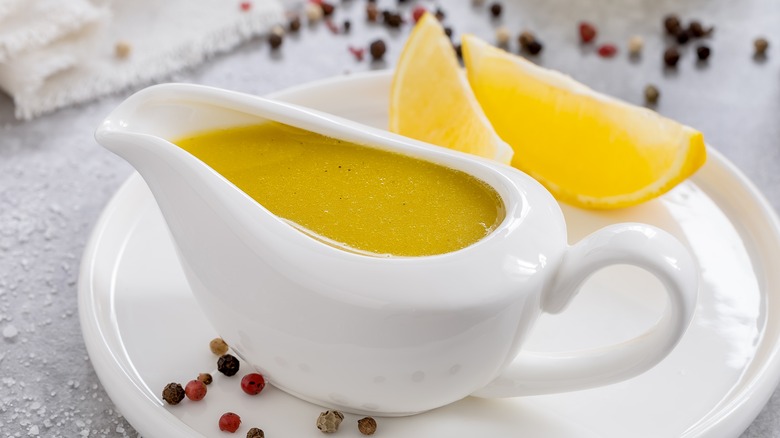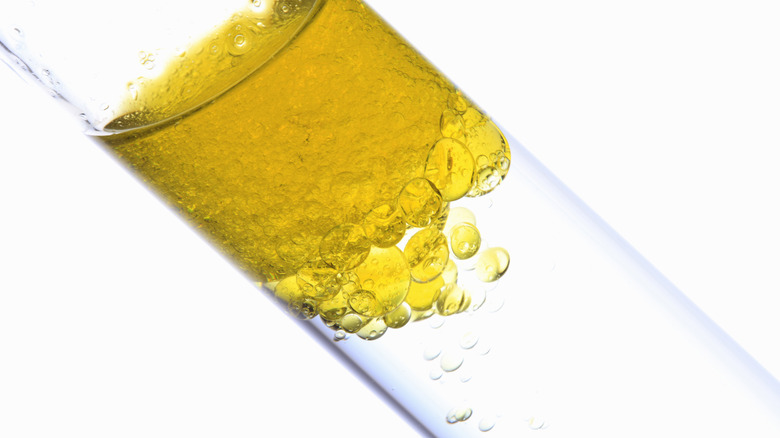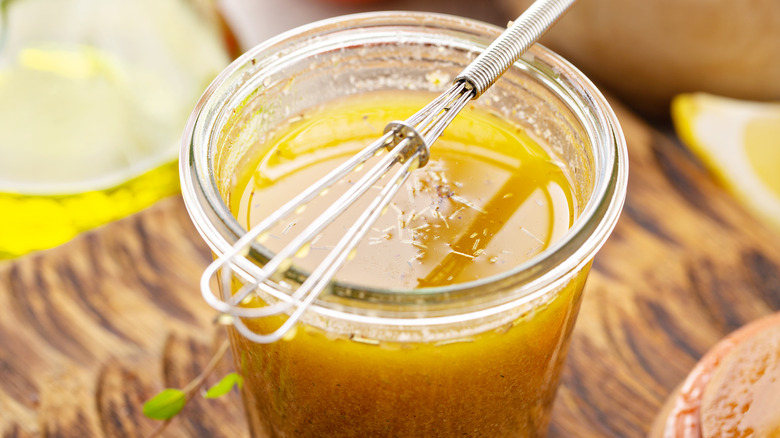The Best Way To Fix A Broken Vinaigrette Is Almost Too Simple
Everyone's been there: The dinner guests are about to arrive after an arduous cooking session in the kitchen, and the recently prepared vinaigrette has broken. There's no denying that this scenario may rightfully put some in a panic, but there are quite a few ways of fixing a separated dressing with a base of oil plus a watery and acidic fluid. However, some methods are more straightforward in a pinch than others, especially when there's no time to augment the recipe. Hence, the easiest way to fix a split vinaigrette is to give it a good shake.
You can also put it through a quick blend, but before sticking your broken dressing into the nearest blender, there's one crucial thing to consider: Olive oil isn't the biggest fan of blenders' blades and will turn out bitter – as demonstrated by a Cook's Illustrated experiment — if one attempts to reconstitute a vinaigrette with this specific oil in a food processor. To understand why shaking is best, though, we must first discuss the science of emulsifiers.
Why emulsifiers are crucial
When it comes to vinaigrettes, the key is emulsifiers. While dealing with oils and other liquids, it's essential to remember that oil is hydrophobic. That's not to say the olive or vegetable oil in your kitchen is actually afraid of getting wet. Still, its molecular structure is quite different from many other liquids, in a way that means its molecules are repelled from instead of attracted to water.
Oil is naturally comprised of nonpolar molecules, while water is intrinsically polar. This means that water molecules have both a positive and negative charge, allowing them to bind well with each other. Conversely, because of oil's molecular structure, it carries the same charge throughout, causing it to stay separate from instead of linked to water. As a result, an emulsifier is needed to effectively bring them together.
Emulsifiers work because they encase themselves around liquids, like oils, in dressings but also possess both water- and fat-soluble properties. As a result, this wrapper around the beads of non-watery fluids acts as a barrier that doesn't allow the water and oil to be repelled by one another. Thus, the oil can be spread uniformly throughout the water.
Common ingredients, such as honey, mustard, and mayonnaise, are emulsifiers that work particularly well for vinaigrettes. However, it should be noted that — depending on which ingredients are used within a specific vinaigrette — there will be different ways to fix it, and some types of components, like certain mustards, should be avoided.
Why shaking is the best method
Even with emulsifiers, vinaigrettes are innately unstable. If they're left out too long, they will eventually separate. Yet, in most cases, there are several ways to repair them.
For instance, some will suggest adjusting your ingredient ratios, because too little or too much of one component may reduce the vinaigrette's emulsification ability. At the same time, others advise making a smaller batch and reincorporating the broken dressing back into it. Another method is to add more emulsifiers, reviving the separated condiment. Still, not everyone has the time or patience to experiment with additions or balances, especially if they're in a rush. So, the easiest route is just to re-agitate the mixture.
The simplest way to do this may seem to be sticking it in a blender and giving it a few spins. Nevertheless, as mentioned, this approach has some issues, specifically if the dressing contains olive oil. The intense speed of a blender will be too harsh on the oil and create oxidization, leading to a bitter-tasting vinaigrette.
As a result, the easiest and quickest way to recombine the split dressing is to pour it into a container that can be shaken, like a squirt bottle or even a protein shaker (those tumblers with a whisk ball people carry with them to the gym for a protein shake). Although this may sound too simple, it spreads the oil throughout the liquid again and coats its beads with emulsifiers, fixing the vinaigrette without affecting flavors.


